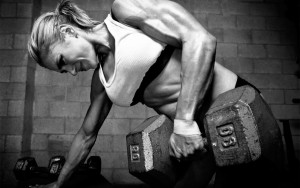Dumbbells vs. Barbells: The Ultimate Guide
Ever wonder whether you should use dumbbells or barbells for strength training? Which weights give the best results? The truth is that both dumbbell and barbell exercises can be equally effective for building mass and strength. It all comes down on how you’re planning to use them.
The dumbbells vs. barbells debate has been around for years. Each type of weight has pros and cons. Dumbbells give you more control and freedom of movement, while barbells are a much better choice for heavy training. To determine which is best for you, it’s important to consider your goals, strength, fitness level, types of exercises, and muscles targeted. A good idea would be to use both of them to keep your muscles guessing and spice up your workouts.
Why Use Barbells?
 The main advantage of barbells is that they allow you to go heavier. For this reason, barbell exercises should come first in your workout. They are also a much better choice for training your legs and lower body. Although you can do squats and deadlifts with dumbbells, barbells allow you to lift more weight. For instance, holding the bar on your back when squatting is more comfortable than holding dumbbells in each hand.
The main advantage of barbells is that they allow you to go heavier. For this reason, barbell exercises should come first in your workout. They are also a much better choice for training your legs and lower body. Although you can do squats and deadlifts with dumbbells, barbells allow you to lift more weight. For instance, holding the bar on your back when squatting is more comfortable than holding dumbbells in each hand.
Barbells are ideal for explosive moves like the clean or press. It’s virtually impossible to generate the same power with dumbbells. The same goes for bench presses. Recent studies have found that most people can lift heavier weights when benching with a barbell. The downside is that working out with barbells masks muscular imbalances, especially when training the chest. Almost everyone has a dominant side. If one arm is stronger than the other, you might not be able to tell the difference.
Most bodybuilders and athletes use barbells for building muscle, and dumbbells for achieving muscle definition. That’s because dumbbells are mostly used for isolation exercises, while the barbell works best for compound moves. Additionally, barbell progression is much easier than dumbbell progression.
Some lifters prefer barbells simply because they’re easier to use and more practical. Barbells are also recommended to those looking to increase the strength a particular muscle group. For example, if you want bigger triceps, use the bar when doing skull crushers. This will allow you to isolate primary muscle groups better than completing the same exercise with dumbbells. When done properly, barbell exercises can lead to greater strength development.
The Cons of Barbell Training
Just like any other piece of equipment, barbells have their drawbacks. First of all, they require a lot of space. If you exercise at home, choose a set of dumbbells rather than a barbell. Research shows that barbells require 42 square feet of floor space versus 24 square feet for the dumbbells training area. Additionally, you’ll need a rack for most barbell exercises. This translates into higher costs and increase space requirements.
The greatest disadvantage of barbell exercises is the high risk of injury. If you use bad form or put too much weight on the bar, you can hurt yourself. Another drawback is that the only way to progress with the barbell is to lift heavier. This can put stress on your joints and muscles, leading to back pain, stiffness, fatigue, and soreness. Make sure you increase the load gradually to prevent injuries.
When you work out with a barbell, you can only lift it up and down. Dumbbells, on the other hand, can be lifted, left or right, forwards or backwards. The bottom line is that barbells can not replace dumbbells or kettlebells. Although more weight equals bigger muscles, you can achieve the same results by mixing dumbbell and barbell training instead of focusing solely on one.
Why Use Dumbbells?
Dumbbells are a favorite choice for newbies as well as for pro  bodybuilders. These accessories are much safer and allow a greater range of motion than the barbell. When training with dumbbells, both sides of your body get the same workout, which helps prevent and fix muscular imbalances. With a barbell, your hands are locked in fixed positions. If you use dumbbells, you can rest your right arm while working with the left arm, and vice versa.
bodybuilders. These accessories are much safer and allow a greater range of motion than the barbell. When training with dumbbells, both sides of your body get the same workout, which helps prevent and fix muscular imbalances. With a barbell, your hands are locked in fixed positions. If you use dumbbells, you can rest your right arm while working with the left arm, and vice versa.
These fitness tools can be used for exercises that isolate smaller muscles as well as for explosive lifting. Dumbbells allow you to work one side at a time, complete drop sets easily, and train without fear of being crushed by the weight on the bar. They also engage smaller muscles that can not be trained with a barbell.
Dumbbells allows you to fully maximize strength and hypertrophy because they can be used for high intensity techniques, such as the rack and run, drop sets, and rest-pause. Additionally, they make it easier for people with injuries to keep working out without causing more harm to the problem areas. For instance, if you have an arm or shoulder injury, you can still train the uninjured arm using dumbbells. These tools are safer than barbells when performing lunges, split squats and other exercises that require balance.
Those who are training at home or don’t have a spotter should definitely choose dumbbells over barbells. These accessories put less stress on the joints and can be used in a multitude of ways. Compared to barbells, they require greater balance and stabilization of the limbs and core. By fixing muscular imbalances, the risk of injury decreases.
The Cons of Dumbbell Training
A major disadvantage of dumbbells is that you’ll need more than one pair to get your workout done. Choosing a different set of dumbbells for every exercise can be stressful and time-consuming. Additionally, they can not be used for heavy training. Most gyms have dumbbells ranging from one pound to 150 pounds or less, so you’ll a barbell to go heavy.
Dumbbell training can lead to injuries too, such as wrist strains, tendonitis, and carpal tunnel syndrome. This can affect your physical performance as well as your overall progress. Another problem is that because of the small hand grip, it’s going to be hard for someone to spot you when lifting heavier weights. If you’re new to exercise, ask someone to teach you proper technique.
There is no need to choose between dumbbells and barbells. Simply customize your workout to get maximum results from each. After all, your muscles respond best to variability and progression. As a rule of thumb, do barbell exercises before dumbbell work. Vary your working angles once every few weeks and watch your form.









